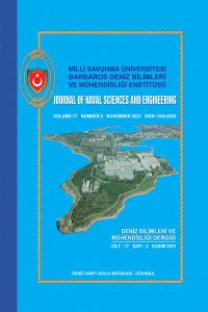A Brief Review on Examination of Exhaust Gas Dispersion on Naval Ships
Anahtar Kelimeler:
-
A Brief Review on Examination of Exhaust Gas Dispersion on Naval Ships
The dispersion of exhaust smoke is affected by a large number of parameters such as efflux velocity and temperature of smoke, level of turbulence, wind velocity and direction, geometry of the structures on ship’s deck etc. For this reason, Analyzing of the dispersion of exhaust smoke from ship stack is really complex. Traditionally, the behavior of the exhaust gases by using scale models in wind tunnels can be investigated. In nowadays, however, as a result of technological advances in numerical computational methods and computers, dispersion of the exhaust gases from Marine ship’s stack can be calculated and high performance funnels of the ship can be designed during pre-design phase. While cruising, ship has a boundary layer. In the sailing ships, these harmful emissions from funnel and high exhaust temperature affects the electronic devices in the ship’s deck and also the health of the crew in the deck. In this study, as a result of this literature review of this topic, a short summary of these studies will be presented. gazlarının dağılımının hesabı karmaşıktır. Geleneksel olarak egzoz gazların davranışı ölçekli modeller kullanılarak rüzgâr tünellerinde incelenebilir. Günümüzde ise sayısal hesaplama metotlarındaki ve bilgisayarlardaki teknolojik gelişmeler sonucunda egzoz gazlarının dağılımı daha kolay bir şekilde hesaplanabilmekte ve yüksek performansa sahip gemi bacaları dizayn edilebilmektedir. Gemiler seyir halinde iken bir sınır tabakaya sahiptir. Egzoz gazları üst binada bulunan sistemlere zarar verebilmekte ve aynı zamanda güvertede çalışan personelin sağlığını da etkilemektedir. Bu çalışmada; konu üzerinde yapılan çalışmaların incelenmesi sonucunda kısa bir literatur özeti sunulacaktır
Keywords:
Exhaust Gas Dispersion, Exhaust Emission Ship,
___
- Gary J. Baham, Donald McCallum, 1977, Stack Design Technology For Marine And Merchant Ships, Sname Transaction, 85, 324-349
- Michael P. Fitzgerald, 1986, A Method To Predict Stack Performance, Marine Engineering Journal
- Eunseok Jin, Jaedon Yoon and Yongsoo Kim, 2001 A Cfd-Based Parametric Study on The Smoke Behavior of A Typical Merchant Ship, Elsevier Science
- G.F.Syms, 2004, Numerical Simulation Of Frigate Airwakes, International Journal of Computational Fluid Dynamics, 18(2), 199-207
- P.R. Kulkarni, S.N. Singh, V.Seshadri, 2005, Flow Visualization Studies of exhaust Smoke- Superstructure Interaction on Marine Ships, Marine Engineering Journal
- P.R. Kulkarni, S.N. Singh, V.Seshadri, 2007, Parametric Studies of Exhaust Smoke– Superstructure Interaction on a Marine Ship Using CFD, Computer&Fluids, 36, 794-816
- R Vijayakumar,V Seshadri, SN Singh, PR Kulkarni, 2008, A Wind Tunnel Study on the Interaction of Hot Exhaust from the Funnel with the Superstructure of a Marine Ship. IEEE Sections Congress. 978-1-4244-2126.
- J.H.Kim, S.M.Park, CHA and S.S. Seol, 2008, Numerical Research on Establishing Optimum Design Criterion of Ship’s Funnel, ASME
- Sunho Park, Jaekyung Heo, Byeong Seok Yu, Shin Hyung Rhee, 2011, Computatıonal Analysis Of Ship’s Exhaust-Gas Flow And Its Application for Antenna Location, Applied Thermal Engineering, 1-14
- S.Ergin, Y.Paralı, E.Dobrucalı, 2012, A Numerical Investigation of Exhaust Smoke- Superstructure Interaction on a Marine Ship, Sustainable Maritime Exploitation of Sea Resources Transportation and
- C.H. Wilkinson, S.J.Zan, N.E.Gilbert, J.D.Funk, 1998, Modelling and Simulation of Ship Air Wakes for Helicopter Operations - A Collaborative Venture, RTO AVT Symposium
- G.F.Syms, 2008, Simulation of Simplified-Frigate Airwakes Using A Lattice-Boltzmann Method, Journal of Wind Engineering and Industrial Aerodynamics, 96, 1197-1206
- Richard G. Lee, Steven J.Zan, 2002, Wind Tunnel Testing to Determine Unsteady Loads on a Helicopter Fuselage in a Ship Airwake, ICAS 2002 Congress
- H.K. Versteeg, W.Malalasekera, 1995, An Introduction to Computational Fluid Dynamics
- Seshadri V, Singh SN. 2000, Wind tunnel studies to obviate the problem of unwarranted rise in air intake temperatures of gas turbines in Marine ship. Technical Report, Applied Mechanics Department, IIT Delhi
- Seshadri V, Singh SN, Kulkarni PR. 2006, A study of the problem of ingress of exhaust smoke into the GT intakes in Marine ships. J Ship Technol;2(1):22–35.
- ISSN: 1304-2025
- Yayın Aralığı: 2
- Başlangıç: 2003
- Yayıncı: Milli Savunma Üniversitesi Deniz Harp Okulu Dekanlığı
Sayıdaki Diğer Makaleler
A Brief Review on Examination of Exhaust Gas Dispersion on Naval Ships
Modeling Study of Solid Oxide Fuel Cell Operating on Reformed NATO F-76 Diesel Fuel
Interpretation of Earthquake Effects on Mechanism Operation: An Experimental Approach
BİYOLOJİK AĞLARDA AĞ MOTİFLERİ VE İNDEKSLEME TEKNİKLERİ
